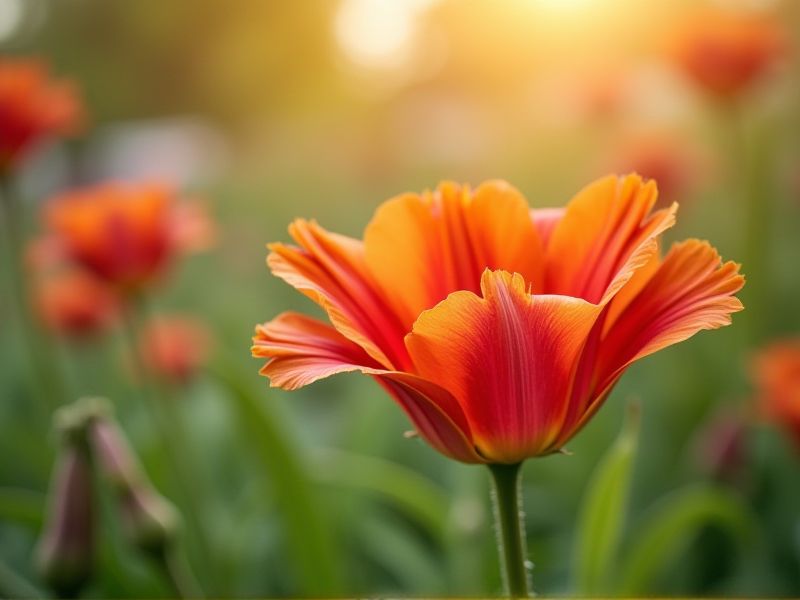
Bask-and-bloom plants thrive in full sun, requiring at least six hours of direct sunlight daily to flourish. Varieties such as sunflowers, lavender, and zinnias are particularly resilient, producing vibrant blooms that attract pollinators like bees and butterflies. These plants typically prefer well-drained soil and moderate watering, ensuring that their roots establish deeply while preventing rot. Integrating these species into your garden can create a lively spectacle, enhancing biodiversity and bringing a burst of color to your outdoor space. Regular deadheading and fertilization can further promote continuous blooming throughout the growing season.
List of some Bask-and-bloom plants that enjoy full sun
- Sunflower (Helianthus annuus)
- Lavender (Lavandula angustifolia)
- Rosemary (Salvia rosmarinus)
- Hibiscus (Hibiscus rosa-sinensis)
- Marigold (Tagetes erecta)
- Coneflower (Echinacea purpurea)
- Sage (Salvia officinalis)
- Red Hot Poker (Kniphofia uvaria)
- Russian Sage (Perovskia atriplicifolia)
- Blanket Flower (Gaillardia pulchella)
Important things about Bask-and-bloom plants that enjoy full sun
Drought Tolerance
Bask-and-bloom plants, such as succulents and some native wildflowers, exhibit remarkable drought tolerance, making them ideal for sunny landscapes. These robust species have adapted to thrive in arid conditions, developing specialized structures like thick leaves or water-storing stems to conserve moisture. Full sun exposure not only enhances their vibrant blooms but also improves their resilience against dry spells, ensuring they maintain their beauty with minimal irrigation. When selecting drought-tolerant plants for your garden, consider options like lavender, agave, or sedum, which will flourish under the sun while requiring little maintenance.
Soil Requirements
Bask-and-bloom plants thrive in well-draining soil, which is essential for their growth and overall health. Aim for a sandy or loamy texture enriched with organic matter to retain moisture while allowing excess water to escape. The ideal pH range for these sun-loving species generally lies between 6.0 and 7.5, promoting optimal nutrient absorption. Ensuring proper soil aeration and drainage will support the vigorous root development these plants require to flourish in full sun environments.
Flowering Season
Bask-and-bloom plants thrive during their flowering season when exposed to full sun, resulting in vibrant blooms and lush foliage. Varieties such as marigolds, zinnias, and sunflowers are ideal for bright, sunny gardens, flourishing under direct sunlight. These plants not only enhance outdoor aesthetics but also attract pollinators like bees and butterflies, creating a lively ecosystem. To ensure optimal growth and flowering, plant these sun-loving species in well-drained soil, providing adequate water to maintain moisture levels without oversaturation.
Maintenance Needs
Bask-and-bloom plants thrive in full sun, requiring regular checks for water and nutrients to maintain their vibrant growth. These sun-loving varieties, such as Sedum and Echinacea, benefit from well-drained soil to prevent root rot, making consistent monitoring essential. To encourage blooming, deadheading spent flowers promotes further growth and extends the flowering period. Regularly applying a balanced fertilizer can enhance their resilience against pests and diseases, ensuring your garden remains stunning throughout the season.
Pest Resistance
Bask-and-bloom plants, such as Echinacea and Rudbeckia, thrive in full sun and exhibit impressive pest resistance, making them ideal choices for resilient gardens. These flowering perennials attract beneficial pollinators while naturally deterring harmful insects due to their robust chemical defenses. When planted in well-draining soil and given adequate sunlight, your garden can flourish with vibrant colors and minimal maintenance. Embracing these hardy varieties not only enhances your landscape but also promotes a healthy ecosystem, contributing to overall garden biodiversity.
Height And Spread
Bask-and-bloom plants thrive in full sun, making them ideal for vibrant garden displays. Typically, these plants range in height from 12 inches to over 3 feet, with a spread varying significantly based on the species, often extending from 18 inches to 4 feet. Varieties such as Lavender and Coneflower not only offer striking blooms but also attract pollinators while being resilient to heat. When selecting bask-and-bloom plants, consider your garden's specific sunlight exposure and ensure they have adequate spacing to showcase their full potential.
Container Suitability
Bask-and-bloom plants thrive in full sun, making them ideal candidates for container gardening in sunny locations. Varieties such as Petunias, Geraniums, and Marigolds not only flourish under bright sunlight but also provide vibrant colors and appealing fragrances, enhancing your outdoor space. When selecting containers, opt for those with adequate drainage holes to prevent waterlogging, ensuring your plants remain healthy and vibrant. You can create a stunning display by mixing different bask-and-bloom species, allowing their unique textures and colors to complement each other beautifully.
Wildlife Attraction
Bask-and-bloom plants that thrive in full sun conditions create vibrant wildlife attractions in gardens and landscapes. Species such as sunflowers, coneflowers, and lantanas not only add stunning visual appeal but also provide vital resources like nectar for pollinators, including bees and butterflies. These plants typically possess deep root systems that help stabilize soil, making them ideal for attracting beneficial insects and promoting biodiversity. By incorporating these sun-loving flora into your garden, you can significantly enhance its ecological value while enjoying the beauty of colorful blooms year-round.
Fertilization Schedules
Bask-and-bloom plants thrive in full sun, requiring a tailored fertilization schedule to optimize their growth and blooming potential. During the active growing season, typically spring through early summer, apply a balanced fertilizer every 4-6 weeks to ensure they receive essential nutrients. Consider using slow-release organic fertilizers, which provide a steady supply of nutrients and enhance soil health over time. Monitor your plants for signs of nutrient deficiencies, such as yellowing leaves or poor growth, to adjust your fertilization approach as needed.
Seasonal Color Variations
Bask-and-bloom plants, such as marigolds and zinnias, thrive in full sunlight, showcasing vibrant seasonal color variations that enhance any garden. During spring and summer, these sun-loving flora display rich yellows, oranges, and vivid reds, attracting pollinators like bees and butterflies. As autumn approaches, the colors may shift to deeper hues, with shades of burgundy and rust, creating a warm and inviting atmosphere. Choosing these plants for your garden not only ensures a striking visual impact but also supports local ecosystems, making them a valuable addition to any outdoor space.
